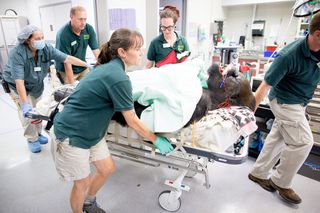425-Pound Gorilla Breathes Easy After Sinus Surgery

For the first time in weeks, a gorilla with a nasty sinus infection is breathing through his nose.
Zookeepers first noticed the runny nose in February, when Vip, a western lowland gorilla, started sniffling. After Vip's symptoms worsened and a round of antibiotics failed to help, animal health staff turned to an ear, nose and throat doctor. Though an expert in sinus disorders, the doctor had only dealt with human patients.
"There're enough similarities that a human doctor can look at an ape," said Martin Ramirez, a mammal curator at Woodland Park Zoo in Seattle. The staff members suspected Vip had a sinus problem, but they had yet to rule out allergies or even a tumor, Ramirez told Live Science. [See Amazing Photos of Gorilla Species]
During the initial examination, "Vip was great," said Dr. Greg Davis, a University of Washington associate professor of otolaryngology-head and neck surgery and director of rhinology and endoscopic skull base surgery. "He was able to let us give him a good exam of his nose."
Davis took photos of the mucus pouring out of the gorilla's nose, and took note that Vip was acting lethargic. "You could tell he was uncomfortable," Davis said.
The zoo's staff was worried about Vip, which stands for Very Important Primate. Now 35 years old, Vip was born in a zoo in the Netherlands and moved to a Boston zoo before coming to Seattle in 1996. He's fathered six daughters, two of which have stayed with him at Woodland Park Zoo, Ramirez said.
When Vip took a turn for the worse, zoo board member and radiologist Dr. Rob Liddell volunteered his computed tomography (CT) scanner to look at the gorilla. Animal health staff administered anesthesia at the zoo, and then called traffic escorts to help them navigate Seattle's busy streets and highways during rush hour on Aug. 20 to get Vip to Dr. Liddell's office.
Sign up for the Live Science daily newsletter now
Get the world’s most fascinating discoveries delivered straight to your inbox.
It took almost an hour to recalibrate the CT scanner for a 425-pound gorilla. But after the scanner began working, both Liddell and Davis determined that Vip had a severe, but operable sinus infection. The infection had started to erode some of the bones inside the skull, and Vip had a significant amount of facial swelling, Davis said.
While Vip was still knocked out, Davis took an endoscope and looked up the gorilla's nose. "His tissue was really inflamed," Davis said. "It was very infected, so I knew that surgery was going to be a bit more of a challenge because of the inflammation he had."
Both of Vip's eyes were swollen shut on Aug. 25, the day of the operation. In the nick of time, Davis had contacted a number of medical instrument suppliers who agreed to donate tools for the surgery.
In the operating room, "It was very strange," said Davis, who said he couldn't stop looking at Vip's large fangs and enormous head. The gorilla's nose acted like an accordion. "You can pull the nose, and it will pull out about an inch and a half to 2 inches [3.8 to 5 centimeters]," making it difficult to use the surgical instruments until Davis applied a special device that kept the nose open, he said. [See Photos of the Gorilla CT Scan and Sinus Surgery]
Davis and the team widened the natural openings in the sinus and removed some tissue and bone. They also took out a large amount of thickened pus. "When you see that in humans, you know there is no way antibiotics are going to work," Davis said. "You have to scoop the pus out."
As the four-hour procedure neared its end, the veterinarians lessened the anesthesia. Vip's nostrils began to flare as he slowly regained consciousness, prompting the team to wrap up quickly.
"When he woke up from the anesthesia, he was breathing through his nose," Davis said. "And that was really cool to see."
Within a day, the swelling on Vip's face lessened and he began eating more. The ape also got angry at a zookeeper, suggesting the gorilla had more energy and was feeling better. During a follow-up visit, "I was able to feed him some cantaloupe," Davis said. "It was incredible to see him back and interacting with his family."
The gorilla is still in guarded condition, and just like humans often do, he took a small turn for the worse a few days after the surgery, Ramirez said. But the doctors expect the animal to make a full recovery within a few weeks.
"The gorilla keepers, they treat the gorillas like family," Davis said. "Seeing how they were so concerned about Vip, it's exactly [like] when you're talking to a family member."
Follow Laura Geggel on Twitter @LauraGeggel and Google+. Follow Live Science @livescience, Facebook & Google+. Original article on Live Science.

Laura is the archaeology and Life's Little Mysteries editor at Live Science. She also reports on general science, including paleontology. Her work has appeared in The New York Times, Scholastic, Popular Science and Spectrum, a site on autism research. She has won multiple awards from the Society of Professional Journalists and the Washington Newspaper Publishers Association for her reporting at a weekly newspaper near Seattle. Laura holds a bachelor's degree in English literature and psychology from Washington University in St. Louis and a master's degree in science writing from NYU.
